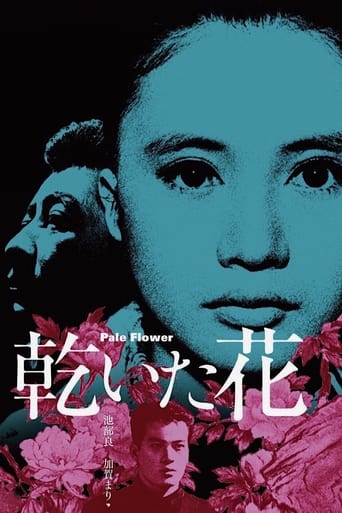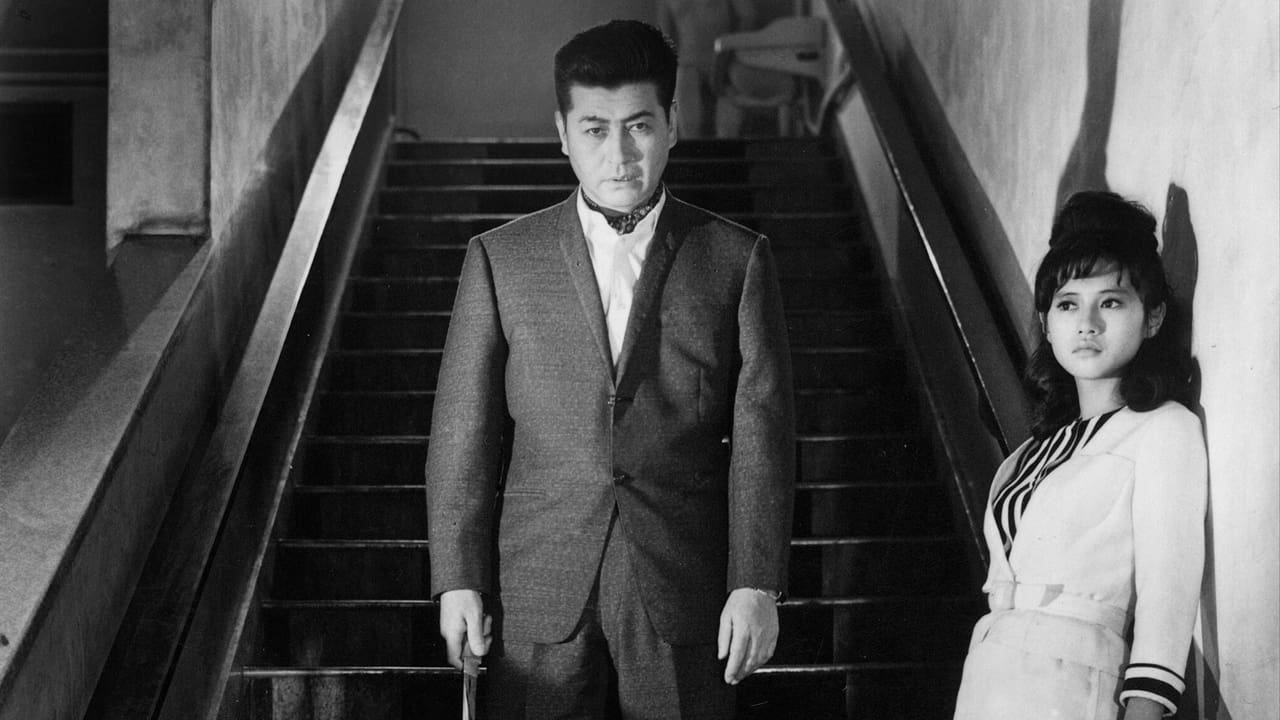gavin6942
A gangster (Ryo Ikebe) gets released from prison and has to cope with the recent shifts of power between the gangs, while taking care of a thrill-seeking young woman (Mariko Kaga), who got in bad company while gambling.Director Shinoda was influenced by Charles Baudelaire's poetry collection "Les Fleurs du mal" while making the film, an unusual source of input for a film. Shinoda chose the subject of yakuza as he felt the yakuza world is the only place where a Japanese ceremonial structure is sustained.Recently (the first half of 2016) I have seen several Japanese gangster films thanks to Arrow Video and their release of "Gangster VIP" and various other Nikkatsu treasures. This film, from Criterion, is different. A bit darker, perhaps. But most interestingly, it has a very active role for a young woman, being not just a love interest but actually driving the plot. That strikes me as being uncommon, maybe even rare.
christopher-underwood
So very black and so very white, so Japanese and so very cool, this is a most impressive film. More new wave than neo-noir, this looks fantastic throughout and if the story is not much and the telling not very fast, it is always arresting. The sparse dialogue is so of the period with talk of boredom, adrenaline rushes and death and if the gambling game itself appears a little basic, the sinister chanting and chip clicking help make for most hypnotic sequences. never mind that the men seem to have to remove their jackets and trousers and shield their chip behind their jacket. The music, at times ambient and at others more jazzy always seems to be spot on, whether we are wandering the back streets of Tokyo and Yokohama or racing in cars along the highway. All performances convince and there are such characters, some only hinted at here, that it seems perfectly possible half a dozen films could have been made.
MisterWhiplash
There was never a moment in the first two thirds (or three quarters, whatever the stretch of time) where I had any dislike for Pale Flower, far from it, I was entranced and involved in this world of back-room gambling parlors in Japan where men put down money they know more than likely they'll lose. But there was a moment at that point I mention where I fell in love with the film: our resident anti-hero Muraki (an incredible-if-only-for-his-presence Ryo Ikebe) is having a dream, only it's a fever dream, or a nightmare, or one of those, involving a girl, Saeko (the oddly pretty Mariko Kaga) who he is infatuated with (but doesn't really love exactly, it's hard to point what it is) and a strange half-Chinese drug-peddler, Yoh (a man who doesn't have a line in the whole film, far as I can tell, aside from possibly some creepy-stalking singing, which I'll get to later). The way the director Masahiro Shinoda has Muraki framed is out of the classic nightmare-scenarios - stuck in slow-motion, dark corridors and shadows where he peers in on the characters that stick in his mind in an inverse tint, and he can't take it.I went back and watched just that scene twice, just to see how Shinoda framed those shots, where he and his DP chose to pull back with the camera. Throughout the film he and his cameraman have an intelligence to their noirish drama, even in the gambling scenes (which, frankly, I still don't totally understand, though this shouldn't be an issue for Japanese audiences so I let it slide), and it culminates with this dream scene. What made it stand out was that the filmmakers tried to not let us in TOO much into this Muraki, and hey, why not? He's an ex-con with three years in the pen for a murder that he is not sure why he did - or rather, he says it was a simple "him or me" survival thing, and doesn't dwell on it much - and drifts from one place to the next. Saeko does give him some sort of lift or interest in the game of gambling they go for, even as Saeko isn't good at it and has a kind of frightening need to have a RUSH for excitement. When they start to drive past 100 (or SHE does I should note) with another car in the middle of the night, there's little explanation, and less so for why she finds this hysterically funny when they're done.But this dream does give us a small window into this man's twisted but empathetic soul. He does want things, or has things he doesn't want, which is this girl he has some care for to not end up with a man who, at one point, stalks him down an empty street at night as if a sinister cat (or a young Harry Lime) was prowling the streets. The plot, as much as it is in the film, doesn't fully kick into gear until the third act anyway as the truce between Yakuza gangs is split by a murder that needs avenging, which, as a sort of self-imposed fate by Muraki would have it, goes where you think it will. The real focus and power and entertainment in Pale Flower is how Shinoda looks at these characters, the rough side that Muraki has just embedded in him, and what humanity (if any) is left in him. This is hard-boiled, existential noir with some experimental beats; it doesn't go quite as far as Branded to Kill, for example, but coming a few years before it is groundbreaking in its small ways.It feels hyper-realistic in an exciting way: a sudden attack at a bowling alley is shocking for how it just seems to be part of the way of things at a bowling alley with a high-profile yakuza like Muraki (more to do with how its shot, that it's one long shot this happens in before the angle finally changes as the assassin is taken away - this too has a twist with the young upstart looking up to Muraki, but this is a supporting story). This is about a man who resides in the shadows since its what he knows best, and is not a total shut-out from his bosses, but is so cold as to seem to more 'normal' gangsters as impenetrable. Indeed it speaks to what Shinoda was going for that he cast Ikebe, who wasn't keen on learning a ton of lines, for his walk(!) Add to that a helluva dame in Saeko with a 'big' performance by Kaga mostly in her eyes, and the strange not-quite-but-yes adversary of Fujiki's Yoh, and you got a gritty noir that has the daring to not just be a B-thriller. Look no further than the climax, which aspires to operatic heights long before HK thriller went for all that jazz, and you get the idea.To put it another way, this is like what I'd imagine, if he saw it, one of a handful of films the author Donald Westlake would be jealous he didn't get to write.
jgcole
Upon his release from prison for killing a rival mobster, Muraki strolls the streets of Tokyo and muses that nothing has changed in three years and that people are little more than half dead stupid animals whose lives are meaningless. In voice-over he asks "What was so wrong with killing one of them?" While he was away the two Tokyo gangs have reached a truce in order to eliminate a third gang from Osaka. Muraki is unsure of his role in the new alliance and places little value in the yakuza (gangster) code. He is a lone wolf who, while a dependable team player, is a risk taker who takes action on his own and finds consolation from his weary existence in the Tokyo nights and its' gambling dens. Saeko is a well dressed, beautiful young woman with lots of cash and, like Muraki, is a creature of the night. They meet at a card game where Saeko recklessly wagers, loses and wants more. A woman in such a place is an oddity and all the players are fascinated by her, including Muraki. When she asks Muraki if he knows of a game where the stakes are higher he knows that he has found what he was looking for. The two are immediately drawn to one another and their fates are sealed. Together they combat the boredom of life with high stakes gambling, high speed joy rides (she drives) and other thrills that come with living on the edge. They agree that whatever they do, they can forgive themselves. "I have no use for the dawn. I adore these evil nights," says Saeko. A truer noir couple there never was. But when Saeko becomes drawn to another mid level yakuza – the half-Chinese junkie Yoh - Muraki feels a sense of loss. To win her back he asks Saeko if she wants to watch him as he assassinates the head of the Osaka syndicate. She cannot say no and he knows it. While it is not a typical yakuza film as there is little bloodshed and killing, it is a gritty portrait of yakuza life: gambling dens, night clubs, racetracks and doing things they have to do and feeling good about it. It is their life and it is unquestioned. It is this that the film is really about: fate and the impending doom that hangs over all of the characters. It reflects the end of the old Japanese tradition of honor and obedience to a patriarchal system that was in disarray after their defeat in WWII and the occupation that followed. The American film noir existentialism and stunning expressionist photography in monochrome Cinemascope create a film experience that is the equal of anything that came out of Europe and the U.S. Even the card game scenes, a game called hana fuda with a deck that has twelve suits all named after flowers, have an intensity that is very noir. There is also a bizarre dream sequence that adds to the stylized strangeness of the film as does the avant garde soundtrack by Toru Takemitsu. The strange and confusing percussion and brass of Takemitsu's score somehow seems in perfect sync with what we are seeing on the screen. This is a complete film experience.


 AD
AD



